The Survival Tin.
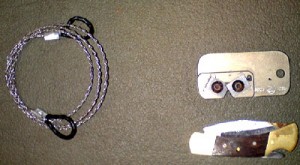
PLAN
There are 4 guiding principles to Survival that will allow you to overcome any potential Survival situation if taught, used and practised correctly. When fully conversant with these principles, a simple tin of goodies really can save your life.
Protection
When in any situation, your first priority is to remove yourself from any further danger and protect yourself; both from the initial setting and from the elements. Cold and rain will sap even the strongest person in a very short space of time. There is no need to 'grizz it out', sit in a huddle and hope for rescue. Proaction gives you the best chance of surviving.
In order to protect yourself from the elements, you have two choices. Depending on the weather and your situation you will either move to gain shelter or make fire. I should add at this point that I am exclusively writing about a temperate environment here where finding water is not of the greatest importance. Should you be in a desert then your priorities will, of course, change.
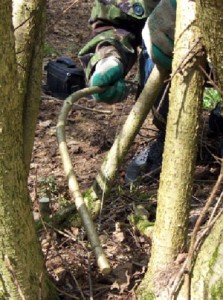 For the sake of this article, I will start with a shelter. Shelters provide protection from the wind and rain while, if constructed correctly, give you insulation from further deterioration and loss of body warmth. Within my survival tin, I have the following items to help me build my shelter. These are:
For the sake of this article, I will start with a shelter. Shelters provide protection from the wind and rain while, if constructed correctly, give you insulation from further deterioration and loss of body warmth. Within my survival tin, I have the following items to help me build my shelter. These are:
- a sharp knife (and sharpener) and
- a wire saw (see featured image above).
The two-handled saw is highly effective on its own but can be improved upon with the use of a sturdy yet flexible branch, such as hazel or willow, to produce a hacksaw type tool. This construction allows the user to operate in a far more efficient and energy-conserving way. The sharp knife is useful in all of the ways that you would expect but neither can really be considered effective for the manipulation of large branches or trunks.
For this we have another tool in our tin: FIRE.
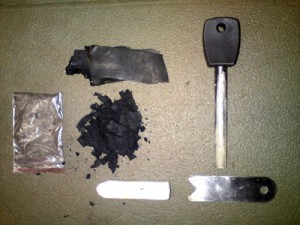 In this photo you can see a Fire Stick and its striker, a tampon (still sealed), some char-cloth and some rubber strips. Fire gives us warmth, morale, protection, boils our water (purification), cooks our food and is also a fantastic way to cut through large branches in an efficient manner. Without going in to a whole fire-lighting lesson here, the striker produces 3000oC sparks. The cotton wool in the tampon ignites from this very readily, giving you the basis from which to add your tinder and kindling.
In this photo you can see a Fire Stick and its striker, a tampon (still sealed), some char-cloth and some rubber strips. Fire gives us warmth, morale, protection, boils our water (purification), cooks our food and is also a fantastic way to cut through large branches in an efficient manner. Without going in to a whole fire-lighting lesson here, the striker produces 3000oC sparks. The cotton wool in the tampon ignites from this very readily, giving you the basis from which to add your tinder and kindling.
Char-cloth is created through the heating of cotton strips in the absence of oxygen to produce strips of very delicate material that will take a spark easily. The rubber strips are your last safe option really. You also need a lighter for this. Simply put, rubber inner tubing burns in any weather and at a temperature hot enough to ignite your tinder and kindling. Why is it the last resort? Because when it's gone, it's gone – you'll always have more sparks! But what if you have no more cotton wool or char-cloth? Well, come on a course to find out how to make fire with natural materials!
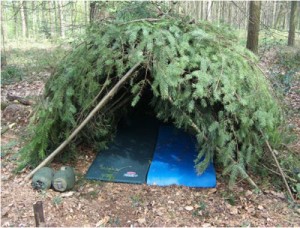 Through the use of fire and the items in the tin, it is possible to build shelters such as the one shown. (sleeping mats not included!) This shelter kept its occupants warm and dry and subsequently stood through some horrendous storms along the south coast.
Through the use of fire and the items in the tin, it is possible to build shelters such as the one shown. (sleeping mats not included!) This shelter kept its occupants warm and dry and subsequently stood through some horrendous storms along the south coast.
Location
After your initial shock has died down, you have put up your shelter and have a fire going, you may need to think about making yourself as locatable as possible. You will want to be discovered as soon as you can.
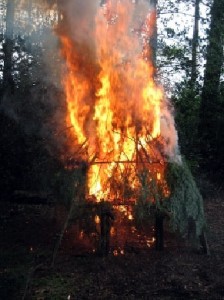 We have already discussed the making of fire but correctly used, fires can give you towering plumes of smoke in the day and blazing infernos at night – perhaps the very best method of being found.
We have already discussed the making of fire but correctly used, fires can give you towering plumes of smoke in the day and blazing infernos at night – perhaps the very best method of being found.
Along with fire, ground-to-air signals should be created in open spaces: 50-foot high symbols giving those searching for you and idea of where you are, how many there are of you and in what state you are in. These need to be made out of any material that heavily contrasts with the surface; even turfing up an otherwise green pasture would suffice.
While you are trying to attract the attention of passing aircraft, ground-to-ground signalling should also be made. The best two methods for this are the use of a whistle ( using the International Distress Signal) and the reflection of bright lights or the sun. In our tin we have both:
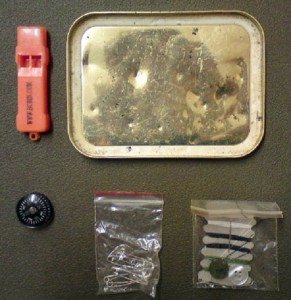 A tin lid such as this will reflect for over a mile and is also detectable from the air.
A tin lid such as this will reflect for over a mile and is also detectable from the air.
Acquisition of Water and Food
Perhaps always the most fun part of any Survival weekend! You can live for 3 mins without air, 3 days without water, 3 weeks without food and 3 months without company (before you go a little mad). Water is the clear priority here in a survival situation. As I mentioned before, if you are in a wet/temperate location then you may change this around.
Within the tin we have a number of items to help collect and purify water. I won't attempt to go in to any detail here because water purification is a hazardous pursuit if not understood properly; again, please come on a course!
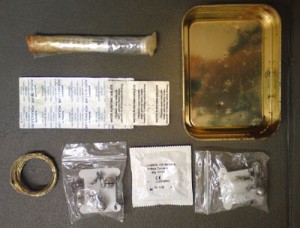 In my tin, I carry a purification straw for desperate last measures. This straw allows me to suck water from ponds, puddles and other water sources with a certain degree of purification. I would not rely on this alone. There are also chlorine tablets, with instructions. Yes, you can see a condom there too. Condoms can carry a phenomenal amount of water but you would obviously not try to carry it 'water-balloon' fashion. You could fashion a carriage container from a log, broken bottle, tree bark to give a structure within which it could be used.
In my tin, I carry a purification straw for desperate last measures. This straw allows me to suck water from ponds, puddles and other water sources with a certain degree of purification. I would not rely on this alone. There are also chlorine tablets, with instructions. Yes, you can see a condom there too. Condoms can carry a phenomenal amount of water but you would obviously not try to carry it 'water-balloon' fashion. You could fashion a carriage container from a log, broken bottle, tree bark to give a structure within which it could be used.
The tin, itself, is a small but useful water collection and boiling vessel. Of course, boiling brings us on to your most useful water purification tool: FIRE (there it is again). A rolling boil for 5mins will kill off all but the most hardy bacteria. I would then follow this up with the purification tablets. However, do not try this at home. There are rules about where you should source your water from. Chemical contamination, for example, CANNOT be removed – this includes farm run off, drains, water from within urban environments!
On the food side of life, we have snare wire and two fishing lines. I have purposefully not put a photograph of snares on here because I already know of a case of 'misuse' from a fellow who looked at a photo, thought he knew what he was doing and injured himself. The snare wire and improvised snares can be used to catch anything from small mammals to deer. Snares are ILLEGAL, if left unattended within the UK.
The two fishing lines are best used as night-lines; hung across a river, they each have four hooks which when baited will hang at different depths across the river. They can be left overnight with no effort spared. Be aware that as with snares, night-lines are ILLEGAL in the UK, full stop. Coupled with your sharp knife, you have methods of procurement and dispatch – tasty meals await!
Navigation
It may not be long in to your survival situation that you decide to try and make a move on your own. For this to happen, you need to know where you are, where you are going and how to let others know. For this you need only the help of a simple button compass (seen in the Location paragraph). Improvising compasses from needles, using ground-sign, reading the weather and using the stars are all methods that you can use in an emergency but the single most useful item in the tin, for me, is the compass – you should carry AT LEAST two.
I will not attempt to go in to detail about navigation at this stage or about how to leave a trail for others to follow, there simply is not enough space on these pages. Needless to say that effective use of a compass will allow you to move freely, safely and towards help. When all rolled in, the tin looks like this: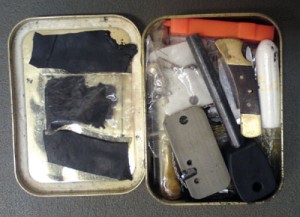
The observant amongst you will notice that there is space remaining. I would usually fill this with more cotton wool, as much as I could, in order to ensure I have fire. Other items that you could squeeze in there are:
- Waterproof paper and pencil.
- Spare Compass.
- Elastic Bands.
- Lighter.
- First Aid Checklist.
- Boiled Sweets.
- Sewing Kit....etc....etc
This tin is very generic. You might want to design your own tin or something larger, such as a grab bag, for use in different situations. Certainly, the emergency bag in my car contains different items to this, such as: a larger knife, axe, shelter sheet, lighter, torch, tinder/kindling, rations, larger compass, GPS, spare clothes, small sleeping bag and mat, solar panel and battery charger, spare batteries........... I hope this has been of a little use, please do not hesitate to contact me for advice, guidance or a place on a course. Best of luck!
John Hayward,
Landrock Survival Training : www.landrock-training.com email : [email protected]
Comments are closed for this post.
Discussion
Interesting.
I personally use Potassium Permanganate instead of Chlorine, (which has a bitter taste).
Like you, all of my Survival Equipment goes into a 2 oz Tobacco Tin, which is easy to slip into your Pocket, and so encourages you to make sure you take it.
The best Survival Kit in the world is no good if it is at home the day you need it!
James.
We went on this course and it was really good – got a free survival tin too ;-)

Great article. I have just started putting a kit together. Just something in the air at the moment. Random and probably just paranoia, but I listen to my gut. I do need a smaller version as at the moment my kit is in a big tin (see at the site I’ve added here).
PaulB
6 April, 2013